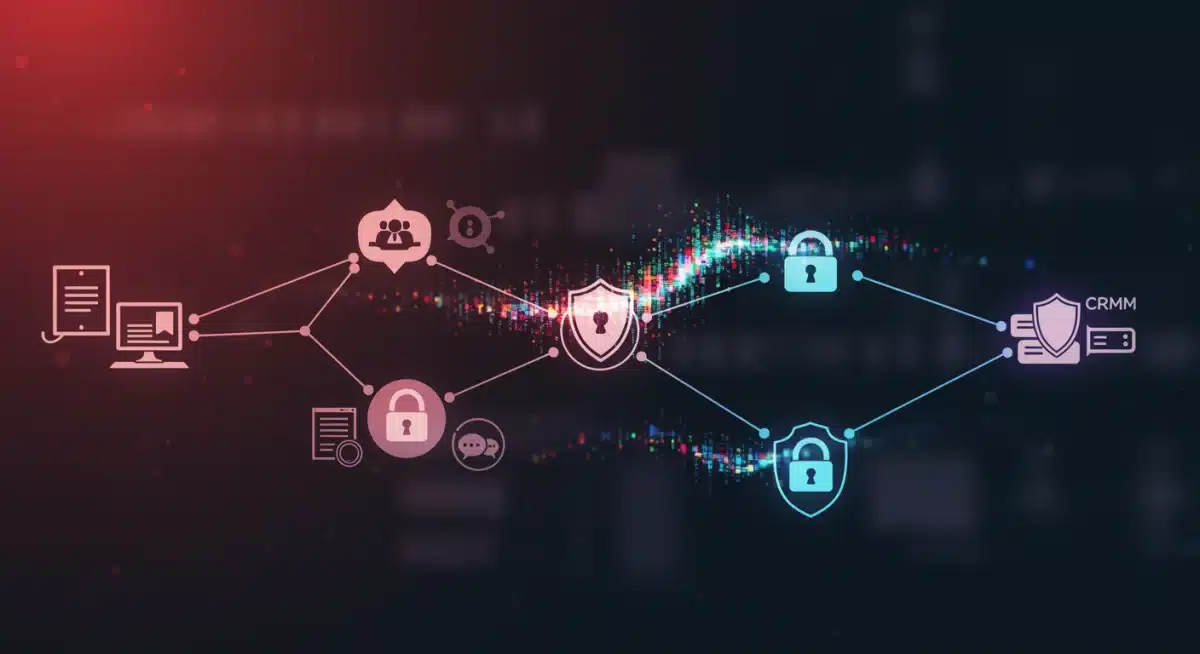Digital Identity Verification: 2025 Roadmap for U.S. Businesses to Combat Fraud

The Digital Identity Verification: A 2025 Roadmap for U.S. Businesses to Reduce Fraud by 25% (PRACTICAL SOLUTIONS) is shaping today’s agenda with new details emerging from officials and industry sources. This update prioritizes what changed, why it matters, and what to watch next, in a clear news format.
As the digital economy expands, U.S. businesses face escalating fraud threats. The imperative to implement robust Digital Identity Verification: A 2025 Roadmap for U.S. Businesses to Reduce Fraud by 25% (PRACTICAL SOLUTIONS) has never been more critical. This article outlines the strategic pathways and actionable steps businesses must take to safeguard their operations and customer trust by 2025, offering a clear vision for mitigating financial crime and enhancing security.
The Escalating Threat of Digital Fraud in the U.S.
U.S. businesses are currently grappling with an unprecedented surge in digital fraud. Reports from the Federal Trade Commission (FTC) indicate that consumers lost billions to fraud in 2023, a significant portion of which originated from digital channels. This escalating threat underscores the urgent need for a cohesive and effective strategy for Digital Identity Verification: A 2025 Roadmap for U.S. Businesses to Reduce Fraud by 25% (PRACTICAL SOLUTIONS).
The landscape of digital fraud is constantly evolving, with fraudsters employing sophisticated techniques such as synthetic identity fraud, account takeovers, and phishing scams. These attacks not only result in direct financial losses but also erode customer trust and damage brand reputation. Without a proactive and adaptive approach, businesses risk falling behind in the arms race against cybercriminals.
Understanding the Current Fraud Landscape
- Synthetic Identity Fraud: Fraudsters combine real and fake information to create new identities, making detection challenging for traditional verification methods.
- Account Takeovers (ATO): Criminals gain unauthorized access to legitimate customer accounts, leading to fraudulent transactions and data breaches.
- Phishing and Social Engineering: Deceptive tactics used to trick individuals into revealing sensitive personal information, often as a precursor to larger fraud schemes.
Addressing these threats requires a multi-layered approach to digital identity verification, moving beyond simple password protection to more rigorous and dynamic verification processes. The goal is not merely to react to fraud but to prevent it proactively, setting a new standard for digital security.
Core Pillars of the 2025 Digital Identity Verification Roadmap
The 2025 roadmap for Digital Identity Verification: A 2025 Roadmap for U.S. Businesses to Reduce Fraud by 25% (PRACTICAL SOLUTIONS) is built upon several foundational pillars designed to create a resilient and adaptive defense against fraud. These pillars encompass technological advancements, regulatory compliance, and a strong focus on user experience.
Successfully implementing this roadmap means integrating advanced technologies like artificial intelligence (AI) and machine learning (ML) into existing verification workflows. It also involves adhering to evolving regulatory standards and fostering collaboration across industries to share threat intelligence and best practices. A holistic strategy ensures that businesses are not only compliant but also genuinely secure.
Key Technological Advancements
- Biometric Authentication: Utilizing unique physical or behavioral characteristics (fingerprints, facial recognition, voice patterns) for enhanced security and user convenience.
- AI and Machine Learning: Employing algorithms to detect anomalies, analyze behavioral patterns, and identify fraudulent activities in real-time, improving detection rates and reducing false positives.
- Decentralized Identity (DID): Exploring blockchain-based solutions where individuals control their own digital identities, potentially reducing reliance on centralized databases and enhancing privacy.
These technological advancements, when strategically deployed, can transform the effectiveness of digital identity verification. The roadmap emphasizes not just adopting new tech, but integrating it seamlessly to create a robust and user-friendly verification ecosystem.
Practical Solutions for Implementation: A Step-by-Step Guide
Implementing a comprehensive Digital Identity Verification: A 2025 Roadmap for U.S. Businesses to Reduce Fraud by 25% (PRACTICAL SOLUTIONS) requires a structured approach. Businesses need to assess their current capabilities, identify vulnerabilities, and then strategically deploy solutions that offer both security and scalability.
The practical solutions outlined in this roadmap focus on immediate and measurable impacts, aiming for that 25% reduction in fraud by 2025. This involves a combination of enhanced onboarding processes, continuous monitoring, and proactive threat intelligence sharing. Each step is designed to build upon the last, creating a layered defense that is difficult for fraudsters to penetrate.
Enhancing Customer Onboarding with Advanced Verification
The initial customer onboarding process is a critical juncture for fraud prevention. Implementing robust identity verification at this stage can significantly reduce the entry points for fraudsters. This includes leveraging multi-factor authentication (MFA) and document verification technologies.

For example, businesses can integrate advanced document verification solutions that use AI to analyze government-issued IDs for authenticity, cross-referencing data points and detecting sophisticated forgeries. This process should be seamless for legitimate customers while providing a strong deterrent to fraudulent attempts.
Continuous Monitoring and Behavioral Analytics
Identity verification isn’t a one-time event; it’s an ongoing process. Continuous monitoring of user behavior and transaction patterns is essential for detecting fraudulent activities that might bypass initial verification. Behavioral analytics, powered by AI, can flag suspicious actions in real-time.
This involves analyzing login patterns, transaction amounts, geographic locations, and device characteristics. Any deviation from a user’s typical behavior can trigger additional verification steps or flag the account for manual review, significantly limiting the damage from account takeovers or other post-onboarding fraud.
Leveraging Data and Analytics for Proactive Fraud Detection
Data is the cornerstone of effective fraud prevention. By leveraging advanced data analytics, U.S. businesses can transition from reactive fraud detection to proactive prevention, anticipating and neutralizing threats before they materialize. This is a crucial component of the Digital Identity Verification: A 2025 Roadmap for U.S. Businesses to Reduce Fraud by 25% (PRACTICAL SOLUTIONS).
The sheer volume of digital transactions generates vast amounts of data that, when properly analyzed, can reveal patterns indicative of fraudulent activity. Modern analytical tools can process this data at speeds and scales impossible for human analysis, providing invaluable insights into emerging fraud trends and vulnerabilities.
Implementing Predictive Analytics
- Pattern Recognition: Identifying recurring characteristics in fraudulent transactions to predict future attacks.
- Risk Scoring: Assigning a risk score to each transaction or user session based on various data points, allowing for dynamic verification responses.
- Fraud Hotspot Identification: Pinpointing geographical areas or specific digital channels that are more prone to fraudulent activities.
By employing predictive analytics, businesses can fine-tune their verification protocols, allocating resources more efficiently and strengthening defenses where they are most needed. This intelligent approach minimizes friction for legitimate users while maximizing protection against fraud.
Regulatory Compliance and Industry Collaboration
Navigating the complex landscape of regulatory compliance is paramount for any U.S. business implementing advanced digital identity verification. Adherence to standards such as the Bank Secrecy Act (BSA), Anti-Money Laundering (AML) regulations, and Know Your Customer (KYC) guidelines is not just a legal obligation but a critical element of building trust and credibility.
Furthermore, effective fraud reduction is not a solitary endeavor. Industry collaboration and information sharing are vital for staying ahead of sophisticated criminal networks. Participating in industry forums and sharing anonymized threat intelligence can significantly bolster collective defenses against evolving fraud tactics, reinforcing the spirit of the Digital Identity Verification: A 2025 Roadmap for U.S. Businesses to Reduce Fraud by 25% (PRACTICAL SOLUTIONS).
Key Regulatory Frameworks
- BSA/AML: Mandates that financial institutions report suspicious activities and establish robust internal controls to prevent money laundering and terrorist financing.
- KYC: Requires businesses to verify the identity of their clients to prevent fraud, money laundering, and other illegal activities.
- Data Privacy Regulations (e.g., CCPA, state-level laws): Ensures that customer data collected during verification is handled responsibly and securely, protecting privacy rights.
Maintaining compliance while innovating in identity verification requires a delicate balance. Businesses must adopt solutions that not only meet regulatory requirements but also offer flexibility to adapt to future changes, ensuring long-term security and legal standing.
Building a Culture of Security and Trust

Beyond technology and compliance, a fundamental shift towards a culture of security and trust is essential for the success of any Digital Identity Verification: A 2025 Roadmap for U.S. Businesses to Reduce Fraud by 25% (PRACTICAL SOLUTIONS). This involves educating employees, empowering customers, and fostering an environment where security is a shared responsibility.
Employees are often the first line of defense against fraud, and their awareness and training are crucial. Similarly, educating customers about best practices for digital security, such as strong passwords and vigilance against phishing, can significantly reduce their vulnerability. A transparent approach to security builds confidence and reinforces the value proposition of a trusted digital service.
Empowering Employees and Customers
- Employee Training: Regular training programs on fraud detection, cybersecurity best practices, and the importance of identity verification protocols.
- Customer Education: Providing clear, accessible information to customers about how their identity is verified, why it’s important, and how they can protect themselves.
- Transparent Communication: Being open about security measures and incident response plans to build and maintain customer trust.
By investing in both technological solutions and human capital, U.S. businesses can create a robust defense against fraud that is both effective and sustainable. This holistic approach ensures that security is not just a feature, but an integral part of the business’s operational DNA.
Measuring Success and Adapting to Future Challenges
The Digital Identity Verification: A 2025 Roadmap for U.S. Businesses to Reduce Fraud by 25% (PRACTICAL SOLUTIONS) is not a static document; it requires continuous evaluation and adaptation. Measuring the effectiveness of implemented solutions and remaining agile in the face of new fraud vectors are critical for long-term success.
Key performance indicators (KPIs) such as fraud rates, false positive rates, customer onboarding friction, and cost of fraud will be essential in tracking progress towards the 25% reduction target. Regular reviews and adjustments based on performance data and emerging threat intelligence will ensure the roadmap remains relevant and effective.
Key Performance Indicators for Fraud Reduction
- Fraud Loss Reduction: Direct financial savings from prevented fraudulent transactions.
- False Positive Rate: The percentage of legitimate transactions incorrectly flagged as fraudulent, impacting customer experience.
- Customer Conversion Rates: Impact of verification processes on new customer sign-ups and existing customer engagement.
The digital landscape is dynamic, and so too must be the approach to identity verification. Businesses that embrace continuous improvement and adaptability will be best positioned to not only meet the 2025 fraud reduction target but also maintain a secure and trustworthy digital environment for years to come.
Key Aspect |
Brief Description |
|---|---|
Fraud Landscape |
U.S. businesses face escalating digital fraud, demanding urgent verification strategies. |
Core Pillars |
Roadmap relies on advanced tech, regulatory compliance, and user experience. |
Practical Solutions |
Enhanced onboarding, continuous monitoring, and proactive analytics are key. |
Culture of Security |
Employee training, customer education, and transparent communication foster trust. |
Frequently Asked Questions About Digital Identity Verification
Digital identity verification is crucial to combat the escalating digital fraud, which cost consumers billions in 2023. Implementing robust solutions by 2025 is essential for U.S. businesses to protect assets, maintain customer trust, and comply with evolving regulations.
U.S. businesses primarily face synthetic identity fraud, where fake identities are created; account takeovers (ATO), where existing accounts are compromised; and phishing/social engineering scams, which trick individuals into revealing sensitive information.
AI and machine learning analyze vast datasets to detect anomalies and behavioral patterns indicative of fraud in real-time. These technologies improve detection rates, reduce false positives, and enable predictive analytics to anticipate and prevent future attacks.
Regulatory compliance with frameworks like BSA, AML, and KYC is fundamental. It ensures legal adherence, builds credibility, and establishes a baseline for security. Businesses must integrate solutions that meet these standards while remaining adaptable to future regulatory changes.
Success can be measured through KPIs such as reduced fraud losses, lower false positive rates, improved customer conversion, and enhanced customer satisfaction. Regular monitoring and data analysis are crucial for evaluating effectiveness and making necessary adjustments to the roadmap.
Outlook: What Happens Next for Digital Identity Verification
The commitment to a Digital Identity Verification: A 2025 Roadmap for U.S. Businesses to Reduce Fraud by 25% (PRACTICAL SOLUTIONS) signals a critical juncture for the digital economy. As businesses continue to implement these strategies, the focus will shift towards refining AI-driven solutions, enhancing cross-sector collaboration, and advocating for standardized interoperable digital identity frameworks. The next phase will demand even greater agility and innovation to counter increasingly sophisticated threats, ensuring a safer and more trustworthy online environment for all.





